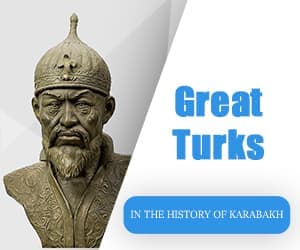In the short time since its foundation, the Karabakh Khanate gained significant political and economic influence in the region. Qarabag.com provides inputs regarding the rulers of the Khanate from the Turkic family of Javanshirs and their contribution to history.
Panah Ali bey (abt 1693 — 1759) came from the Turkic clan of Javanshirs.
The Javanshirs, which did not support Nadir Shah in 1736, was evicted from Karabakh to Khorasan. Panah Ali bey’s brother, Fazl Ali bey, who had served Nadir Shah as an Eshikagasi (adjutant), was killed and, fearing for his life, Panah Ali bey fled to Karabakh with his entourage in 1738.
[E.E. Ismayilov The Caucasus and Globalization. Vol. 8, issue 1-2, 2014. Article: Karabakh Khans: The origin of the clan, the subordination of the Khanate to the Russian Empire. Page 146]
After the death of Nadir Shah in 1747, Panah Ali bey subdued most of the former Beglyarbek of Karabakh and created the Karabakh Khanate.
[E. E. Ismayilov The Caucasus and Globalization. Vol. 8, issue 1-2, 2014. Article: Karabakh Khans: The origin of the clan, the subordination of the Khanate to the Russian Empire. Page 146]
In 1748, Panah Ali Khan built the first capital of the Khanate — Bayat Castle.
[ E.E. Ismayilov The Caucasus and Globalization. Vol. 8, issue 1-2, 2014. Article: Karabakh Khans: The origin of the clan, the subordination of the Khanate to the Russian Empire. Page 146]
In the same year, the new Persian Shah Adil (1747-1748), the nephew of Nadir Shah, recognized him as the Khan of Karabakh.
[E. E. Ismayilov The Caucasus and Globalization. Vol. 8, issue 1-2, 2014. Article: Karabakh Khans: The origin of the clan, the subordination of the Khanate to the Russian Empire. Page 147]
In 1751/1752, Panah Ali Khan moved all the inhabitants from Bayat to Shahbulagy Fortress that had built by him.
[E. E. Ismayilov The Caucasus and Globalization. Vol. 8, issue 1-2, 2014. Article: Karabakh Khans: The origin of the clan, the subordination of the Khanate to the Russian Empire. Page 147]
In 1750-1755, Panah Ali Khan annexed Zangezur to the Karabakh Khanate.
[Mirza Jamal Javanshir Karabaghi. The history of Karabakh. Baku, 1959. Page 70]
In 1756, when the construction of the new fortress of Shusha was fully completed, the khan moved all the inhabitants from Shahbulagy Fortress. At first, this city was called Panahabad in the honor of the khan.
[E.E. Ismayilov The Caucasus and Globalization. Vol. 8, issue 1-2, 2014. Article: Karabakh Khans: The origin of the clan, the subordination of the Khanate to the Russian Empire. Page 147]
Panah Ali Khan died in Shiraz in 1759. He was buried in the family cemetery of the Karabakh Khans in Aghdam.
[ E.E. Ismayilov The Caucasus and Globalization. Vol. 8, issue 1-2, 2014. Article: Karabakh Khans: The origin of the clan, the subordination of the Khanate to the Russian Empire. Pp. 147-148]
Ibrahim Khalil Khan (1732-1806), the ruler of the Karabakh Khanate since 1759, the son of Panah Ali Khan. During his reign, the Karabakh Khanate was one of the most powerful Azerbaijani khanates. He fought against the invasion of the troops of Agha Mohammad Khan of the Turkic dynasty of Qajars, who became the ruler of the Qajar State in 1796.
[E.E. Ismayilov The Caucasus and Globalization. Vol. 8, issue 1-2, 2014. Article: Karabakh Khans: The origin of the clan, the subordination of the Khanate to the Russian Empire. Pp. 148-149]
In 1768/1769, by order of Ibrahim Khalil Khan, a large cathedral mosque was built in Shusha, later restored by his daughter Gevhar aga.
[Mirza Jamal Javanshir Karabaghi. The history of Karabakh. Baku, 1959. Page 101]
On May 14, 1805, Ibrahim Khalil Khan signed the Treaty of Kurakchay according to which the Karabakh Khanate became a subject of the Russian Empire.
[E.E. Ismayilov The Caucasus and Globalization. Vol. 8, issue 3-4, 2014. Article: Khans of Karabakh: Generational description of the senior line of the family Page 134]
On July 8, 1805, by the decree of the Emperor of Russia, he was promoted to Lieutenant General.
[E. E. Ismayilov The Caucasus and Globalization. Vol. 8, issue 3-4, 2014. Article: Khans of Karabakh: Generational description of the senior line of the family Page 135]
In 1806, he was killed by the rangers of Lieutenant Colonel Lisanevich’s regiment.
[E.E. Ismayilov The Caucasus and Globalization. Vol. 8, issue 3-4, 2014. Article: Khans of Karabakh: Generational description of the senior line of the family Page 135]
Mehdi Gulu Khan (abt 1763 or abt 1772-1845), came to power after the death of his father, Ibrahim Khalil Khan, in 1806.
A year earlier, on July 8, 1805, by the order of the Emperor of Russia, he was promoted to Major General.
[E. E. Ismayilov The Caucasus and Globalization. Vol. 8, issue 3-4, 2014. Article: Khans of Karabakh: Generational description of the senior line of the family Page 137]
“During the period of General Ermolov’s administration of the Caucasus (1816-1827), one of the purposes of which was to deprive the Azerbaijani khans of their possessions, Mehdi Gulu Khan was forced to flee to the Persian possessions on 21 November 1822, after which the Khan’s authority in Karabakh was abolishedv in 1822, December”.
[E.E. Ismayilov The Caucasus and Globalization. Vol. 8, issue 3-4, 2014. Article: Khans of Karabakh: Generational description of the senior line of the family Page 138]
In 1827 he was granted to Ak-Karavan-Saray. Later, he was returned to the rank of Major General and personal estates.
[E.E. Ismayilov The Caucasus and Globalization. Vol. 8, issue 3-4, 2014. Article: Khans of Karabakh: Generational description of the senior line of the family Pp. 138- 139]
Mehdi Gulu Khan Karabagi died in Aghdam on May 14, 1845.
[E.E. Ismayilov The Caucasus and Globalization. Vol. 8, issue 3-4, 2014. Article: Khans of Karabakh: Generational description of the senior line of the family Page 139]




